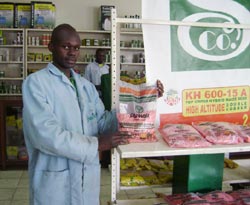Farm mechanization & conservation agriculture for sustainable intensification project launched
If asked “What is the most limiting factor to cereal production in sub-Saharan Africa,” most agronomists would say water, nitrogen, or phosphorus. Could farm power also have a place in this list? From 25 to 30 March 2013, a multidisciplinary group of 40 agronomists, agricultural engineers, economists, anthropologists, and private sector representatives from Kenya, Tanzania, Australia, India, and other countries attended a meeting in Arusha, Tanzania, to officially launch the ‘Farm Mechanization & Conservation Agriculture for Sustainable Intensification’ project, supported by the Australian International Food Security Centre (AIFSC) and managed by the Australian Centre for International Agricultural Research (ACIAR). The meeting focused largely on planning for activities that will take place in Kenya and Tanzania, but the project will eventually explore opportunities to accelerate the delivery and adoption of two-wheel tractors (2WTs) based conservation agriculture (CA) and other 2WT-based technologies (transport, shelling, threshing) by smallholders in Ethiopia, Kenya, Tanzania, and Zimbabwe. This project will be implemented over the next four years by CIMMYT and its partners.
Why do these issues matter? In many countries, the number of tractors has declined in the past decades (as a result of structural adjustment plans, for example), and so did the number of draught animals in many parts of the continent (due to biomass shortage, droughts, diseases, etc.). As a result, African agriculture increasingly relies on human muscle power. This problem is compounded by labor shortages arising from an ageing population, rural-urban migration, and HIV/ AIDS. Even in areas where rural population is increasing faster than the cultivated area, labor may be in short supply during critical field operations due to competition with more rewarding sectors, such as construction and mining. One consequence of low farm mechanization is high labor drudgery, which disproportionately affects women, as they play a predominant role in weeding, threshing, shelling, and transport by head-loading, and which makes farming unattractive to the youth. Sustainable intensification in sub-Saharan Africa appears unlikely if the issue of inadequate and declining farm power is not addressed. Power supply could be increased through appropriate and equitable mechanization, while power demand could be reduced through power saving technologies such as CA. Synergies can be exploited between these two avenues: for example, the elimination of soil inversion in CA systems reduces power requirements —typically by a factor of two— making the use of lower powered and more affordable tractors such as 2WTs a viable option. 2WTs are already present in Eastern and Southern Africa, albeit in low numbers and seldom used for CA in most countries. Several CA planters adapted for 2WTs have also been developed recently and are now commercially available. These are both manufactured outside (e.g. China, Brazil) and in the region (e.g. in Kenya and Tanzania).
The first set of the project’s activities will aim at identifying likely farmer demand by defining main sources of unmet power demand and labor drudgery. This will help determine the choice of technologies – from the 2WT-based technologies available for CA (seed drilling, strip tillage, ripping, etc.) and non-CA operations (transport, threshing, shelling) – to evaluate on-station and on farm, with participation of farmers and other stakeholders involved in technology transfer. The second set of activities will aim at identifying and testing site-specific unsubsidized business models – utilizing private sector service providers to support market systems – that will enable efficient and equitable delivery of the most promising 2WT-based technologies to a large number of smallholders; technologies affordable to the resource-poor and women-headed households. The project will also examine the institutional and policy constraints and opportunities that may affect the adoption of 2WT-based technologies in the four countries. Finally, it will create awareness on 2WT-based technologies in the sub-region and share knowledge and information with other regions, thanks to the establishment of a permanent knowledge platform hosted by the African Conservation Tillage network.
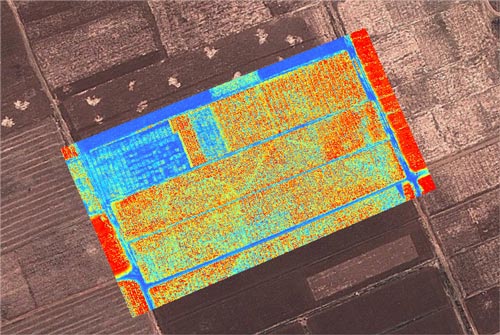 To free phenotyping of the varietal development bottleneck label, many new tools have been developed to enable an easier plant growth and development characterization and field variability. Until recently, these tools’ potential has been limited by the scale on which they can be used, but this is changing: a new affordable field-based phenotyping platform combining cutting edge aeronautics technology and image analysis was developed through collaboration between researchers from the
To free phenotyping of the varietal development bottleneck label, many new tools have been developed to enable an easier plant growth and development characterization and field variability. Until recently, these tools’ potential has been limited by the scale on which they can be used, but this is changing: a new affordable field-based phenotyping platform combining cutting edge aeronautics technology and image analysis was developed through collaboration between researchers from the 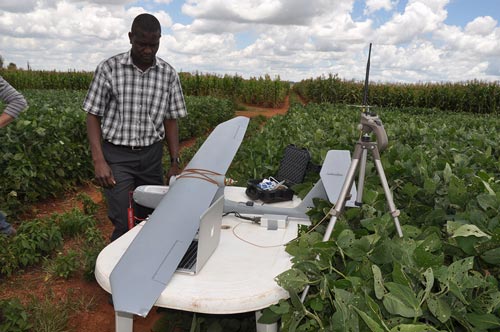 The new platform uses ‘Sky Walker,’ an unmanned aerial vehicle which can fly at over 600-meter with an average speed of 45 km/h. The vehicle has thermal and spectral cameras mounted under each wing, and its flight path and image capturing are controlled via a laptop using Google Earth images. Jill Cairns and Mainassara Zaman-Allah tested the platform at CIMMYT-Harare along with José Luis Araus (University of Barcelona), Antón Fernández (AirElectronics president), and Alberto Hornero (Sustainable Agricultural Institute of the High Research Council) to establish the optimal flight path (distance between plane passes and height) for plot level measurements. Field experiments were phenotyped for spectral reflectance and canopy temperature within minutes; these will be compared to results from the GreenSeeker.
The new platform uses ‘Sky Walker,’ an unmanned aerial vehicle which can fly at over 600-meter with an average speed of 45 km/h. The vehicle has thermal and spectral cameras mounted under each wing, and its flight path and image capturing are controlled via a laptop using Google Earth images. Jill Cairns and Mainassara Zaman-Allah tested the platform at CIMMYT-Harare along with José Luis Araus (University of Barcelona), Antón Fernández (AirElectronics president), and Alberto Hornero (Sustainable Agricultural Institute of the High Research Council) to establish the optimal flight path (distance between plane passes and height) for plot level measurements. Field experiments were phenotyped for spectral reflectance and canopy temperature within minutes; these will be compared to results from the GreenSeeker.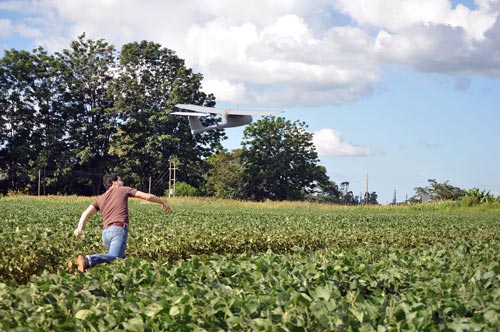
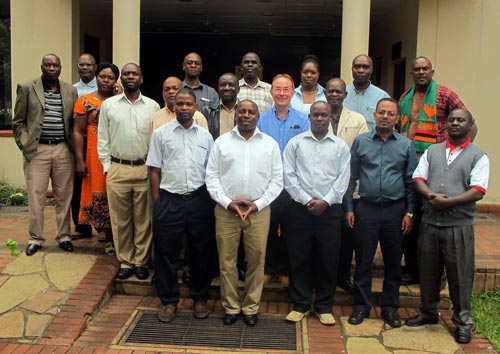
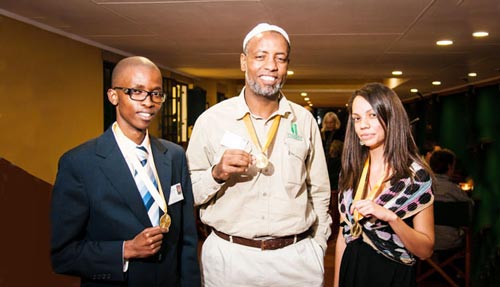
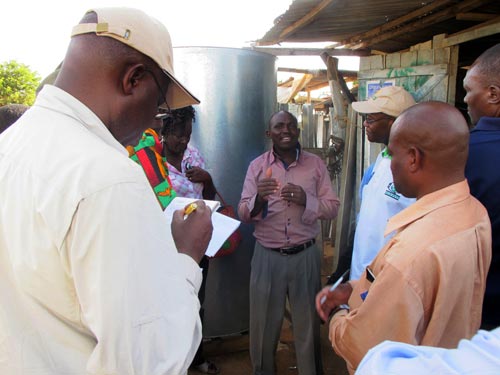 A delegation from Kenya, Malawi, Zimbabwe, and Zambia — the target countries of the Effective Grain Storage for Sustainable Livelihoods of African Farmers (EGSP) Phase-II Project— visited Malawi during 22-23 October and Kenya during 25-26 October 2012 to share experiences with project implementation and to learn about the project’s impact on the livelihoods of smallholder farmers. The delegation comprised of officials from ministries of agriculture and national agricultural research systems from the four EGSP countries, and implementing partners (Kenya Agricultural Research Institute and the Catholic Dioceses of Embu and Homa Bay in Kenya,
A delegation from Kenya, Malawi, Zimbabwe, and Zambia — the target countries of the Effective Grain Storage for Sustainable Livelihoods of African Farmers (EGSP) Phase-II Project— visited Malawi during 22-23 October and Kenya during 25-26 October 2012 to share experiences with project implementation and to learn about the project’s impact on the livelihoods of smallholder farmers. The delegation comprised of officials from ministries of agriculture and national agricultural research systems from the four EGSP countries, and implementing partners (Kenya Agricultural Research Institute and the Catholic Dioceses of Embu and Homa Bay in Kenya, 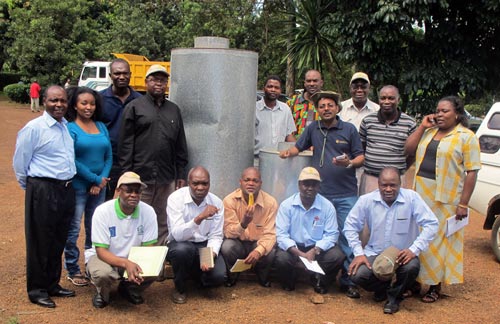
 Thirty-six senior maize breeders from fifteen African countries participated in a course in Nairobi, Kenya, from 1 to 4 October 2012. The course attracted participants from national agricultural research systems, private seed companies, and universities collaborating within the Drought Tolerant Maize for Africa (
Thirty-six senior maize breeders from fifteen African countries participated in a course in Nairobi, Kenya, from 1 to 4 October 2012. The course attracted participants from national agricultural research systems, private seed companies, and universities collaborating within the Drought Tolerant Maize for Africa (
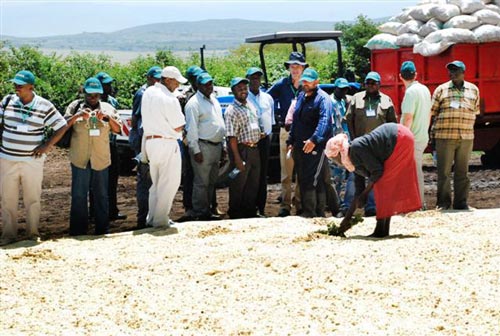
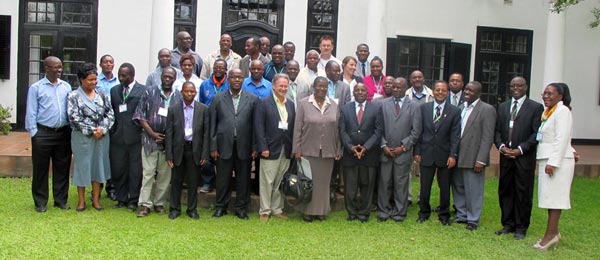
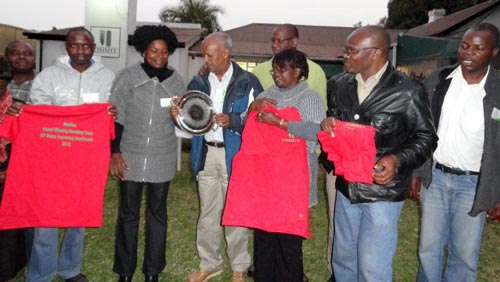 Maize plays a pivotal role in the livelihoods of people in southern Africa: its annual per capita consumption is around 85 kg. In the past season, however, farmers in Angola, Botswana, Lesotho, Swaziland, and much of Zimbabwe experienced a severe drought that significantly reduced their harvests.
Maize plays a pivotal role in the livelihoods of people in southern Africa: its annual per capita consumption is around 85 kg. In the past season, however, farmers in Angola, Botswana, Lesotho, Swaziland, and much of Zimbabwe experienced a severe drought that significantly reduced their harvests.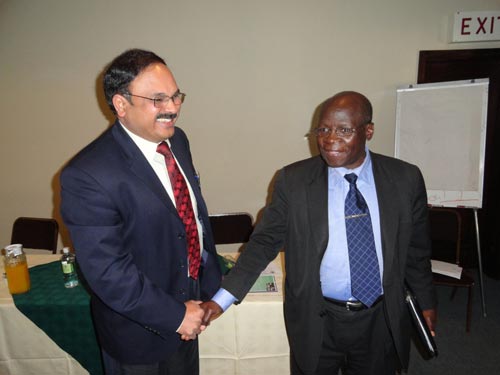 Participants discussed some of their notable achievements from 2011-12. Angola began its first commercial-scale production of the drought tolerant hybrid seed with Agropequária Kambondo and produced significant quantities of the drought tolerant openpollinated variety (OPV) ZM523. Farmers in the Democratic Republic of the Congo produced 80 tons of the drought tolerant OPV ZM623 through community-based seed schemes. Lesotho released a quality protein maize variety, and Zambia’s national program made significant progress in breeding for drought tolerance. Local emerging seed companies in Mozambique have begun production of one drought tolerant OPV and three drought tolerant hybrids.
Participants discussed some of their notable achievements from 2011-12. Angola began its first commercial-scale production of the drought tolerant hybrid seed with Agropequária Kambondo and produced significant quantities of the drought tolerant openpollinated variety (OPV) ZM523. Farmers in the Democratic Republic of the Congo produced 80 tons of the drought tolerant OPV ZM623 through community-based seed schemes. Lesotho released a quality protein maize variety, and Zambia’s national program made significant progress in breeding for drought tolerance. Local emerging seed companies in Mozambique have begun production of one drought tolerant OPV and three drought tolerant hybrids.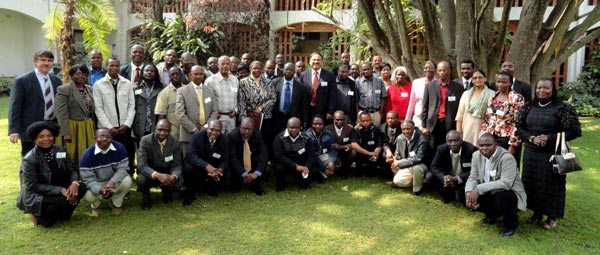
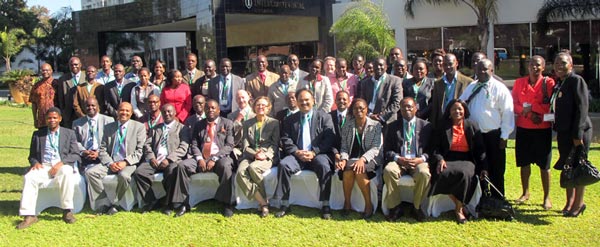
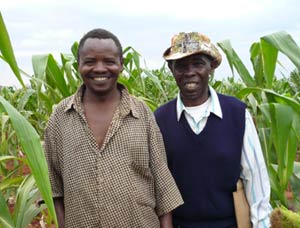 In the 2006-07 cropping season, 82 registered maize seed companies produced the bulk of just over 100,000 tons of improved maize seed that were marketed in the major maize producing countries of eastern and southern Africa (excluding South Africa) — enough to sow 35% of the maize land in those countries.
In the 2006-07 cropping season, 82 registered maize seed companies produced the bulk of just over 100,000 tons of improved maize seed that were marketed in the major maize producing countries of eastern and southern Africa (excluding South Africa) — enough to sow 35% of the maize land in those countries.